NEWS
27.12.2024
How Much Would Tenkaichi Budokai Tickets Cost? We Asked Martial Arts Event Producer Nobuyuki Sakakibara!
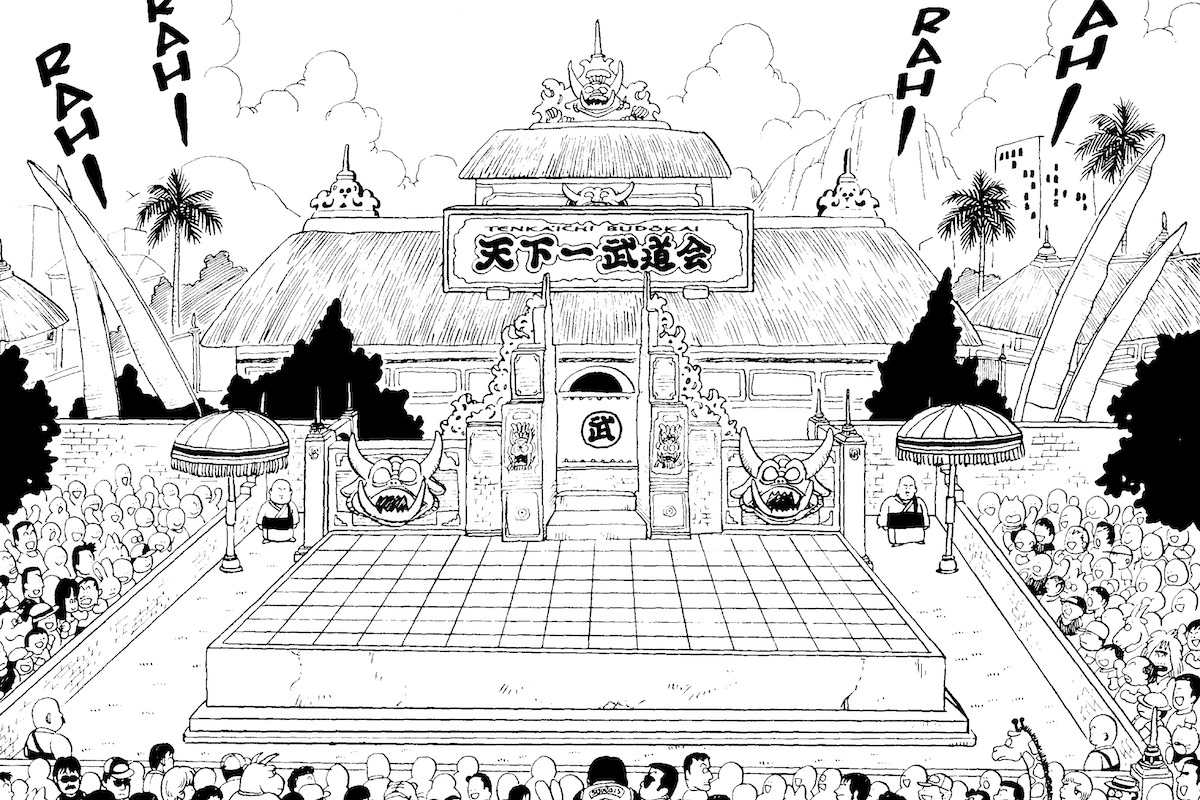
In Dragon Ball, martial arts masters from all over the world gather to compete in the Tenkaichi Budokai for the title of the strongest. Since the first climactic battle in the early days of Dragon Ball, many victors have been born across the tournaments. But what would a martial arts event organizer think about the value and feasibility of the Tenkaichi Budokai as an actual "event"?
This time we've asked Nobuyuki Sakakibara, an organizer behind many famous martial arts events like "RIZIN" and "PRIDE", for his professional opinion on the Tenkaichi Budokai. In particular, we had him analyze whether the Tenkaichi Budokai would realistically work as an event or not, based on the number of attendees and the venues as they're depicted in Dragon Ball, as well as the regulations of such a tournament and other topics.
Sakakibara also shared his thoughts on the Tenkaichi Budokai from the perspective of a successful promoter, including what elements he would add if he were to produce this sort of event.
.jpg?_=1765714500)
Nobuyuki Sakakibara: Born in Aichi Prefecture. President and CEO of Dream Factory Worldwide Co., Ltd. After graduating from university, Sakakibara joined TOKAI TV Enterprise Co., Ltd. and took on the role of producer for various events. He organized the "PRIDE.1" event in 1997, which led to PRIDE holding an unparalleled position in the industry until its sale in 2007. In 2015, Sakakibara launched the "RIZIN FIGHTING FEDERATION". In 2022, he organized the long-awaited fight between Tenshin Nasukawa and Takeru in "THE MATCH 2022".
Contents
・ The Same as Modern Martial Arts Events? How the Tenkaichi Budokai Was Way Ahead of Its Time!・ One Day Isn't Enough for the Tenkaichi Budokai... How Would a Pro Handle This Event?
・ PPV Profits Guaranteed! The Lucrative Business Potential of the Tenkaichi Budokai
・ Was MMA Influenced by the Tenkaichi Budokai?
—Mr. Sakakibara has been a leader in the Japanese martial arts scene for over 20 years. He's been involved with many projects, including PRIDE, since its start in 1997, and the launch of RIZIN in 2015. So, today, we'd like to ask him to think about the Tenkaichi Budokai from the perspective of a martial arts event producer. Speaking of, how well do you know Dragon Ball, Mr. Sakakibara?
Nobuyuki Sakakibara (Hereafter, Sakakibara): I wasn't an avid reader of the manga or anything, but I do know of the Tenkaichi Budokai, and it's been referenced in a lot of martial events I've had a hand in. I have a ton of respect for Akira Toriyama, since he's also from Aichi Prefecture!
—Okay! So, to give a little overview of the Tenkaichi Budokai itself, it's held at a venue on Papaya Island. This tournament to determine the top martial arts master in the world has been held for over 100 years. Up until the 21st Tenkaichi Budokai, when Goku and his pals first participated, the tournament was held once every five years. At the 21st Tenkaichi Budokai there were 137 participants. The entire audience was standing room only, and as a generous estimate, we'd say there were about a few hundred people. First we wanted to ask you, with this information in mind, what's your honest impression of the Tenkaichi Budokai?
Sakakibara: No matter the type of event, the most important thing is the goal of the promoter holding it. So, in the case of the Tenkaichi Budokai, since it's hosted by the martial arts temple, which also serves as the venue of the event, the purpose may be to promote the temple or as part of missionary work. After all, martial arts have their roots in religious rites. As the tournament has continued for over 100 years, it can be said to be fully viable as a business, even if it were in the red.
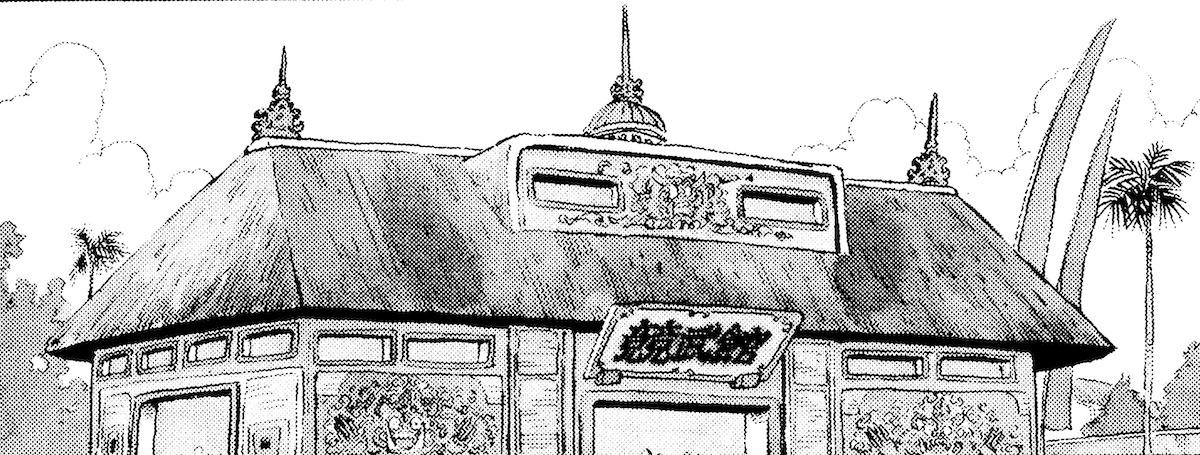
The tournament hall where the Tenkaichi Budokai prelims were held has a distinctive exterior, reminiscent of Asian temples
It is also possible that this event is held to promote tourism on Papaya Island, and public money is used to help fund it. Actually, in cities like Dubai and Riyadh in the middle east, the tourism, entertainment, and sports industries are considered an important next step after the oil business, and MMA (mixed-martial arts) also has the government's support.
Actually, the thing I find the most impressive is the decision to call this event "Tenkaichi Budokai".
—It concisely gets across the idea that this tournament decides the strongest person in the world.
Sakakibara: In the end, that's what martial arts has always been about. Since ancient Rome, everyone wants to know, "Who's the current strongest fighter?" There are a ton of different kinds of martial arts; there's boxing, kickboxing, wrestling, judo, jujutsu, sumo... but who would win if the different champions were pitted against each other? That was the motivation for starting PRIDE 25 years ago, and I think that was also the reason Antonio Inoki became interested in interdisciplinary martial arts.
However, in the real world, I don't think any one event or group exists with the authority to determine a single strongest fighter that everyone would agree upon, in the way the Tenkaichi Budokai does.
—Speaking of interdisciplinary martial arts, all sorts of martial arts showed up in the Tenkaichi Budokai prelims, including sumo, boxing, karate, kenpo, and wrestling!
Sakakibara: Not only are the fights interdisciplinary, but they are also interspecies, too, with even gorilla-looking guys and monsters participating!
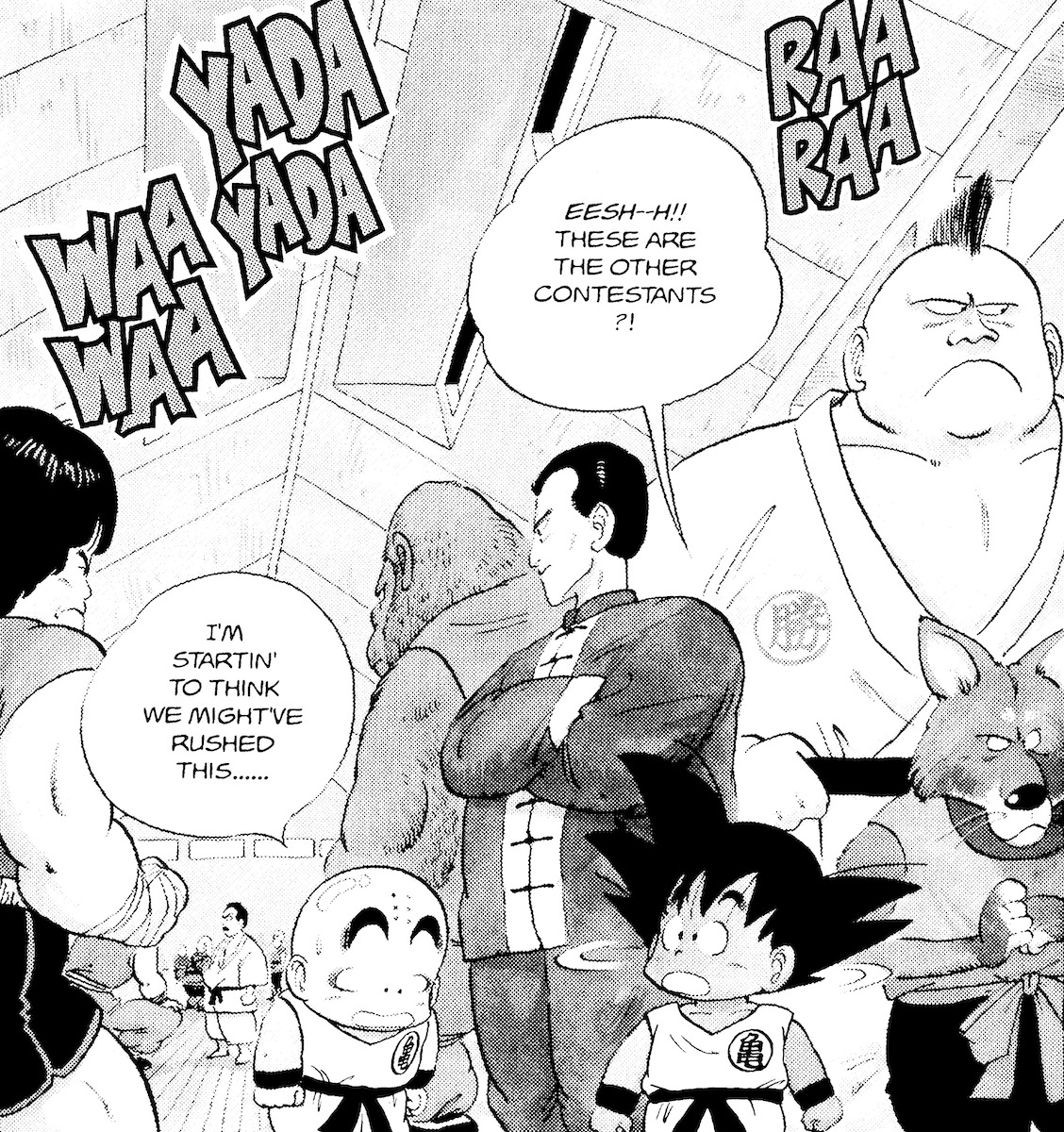
The "gorilla-looking guy" is visible in the back
Maybe someday soon we'll be able to catch up with Toriyama's imagination and do something like "Mikuru Asakura vs. Kaiju" (laughs).
By the way, when was Toriyama's first depiction of the Tenkaichi Budokai?
—It appeared in the manga in 1985.
Sakakibara: That's truly astounding. At that time there was no PRIDE, RIZIN, or UFC (an MMA organization in the US), and the term MMA hadn't even been coined yet! So, Toriyama came up with this multi-type martial arts tournament and incorporated it into his manga, with nothing to base it on.
The rules are also spot on! The qualifying time is one minute (21st Tenkaichi Budokai), which is exactly like the now popular "BreakingDown" (a Japanese martial arts event). I'm absolutely amazed that Toriyama came up with that "one-minute match" nearly 40 years ago!
.jpg?_=1765714500)
—Next, let's talk about some theoretical regulations for a Tenkaichi Budokai competition. The 22nd Tenkaichi Budokai, in which Tenshinhan emerged as the victor, was a particularly tough one. There was no time limit for the qualifying rounds, or the seven rounds in the main event. That means the winner would have had to fight in a total of at least five matches, including the preliminaries, in one day. That's just not possible in reality, so this is a truly insane tournament.
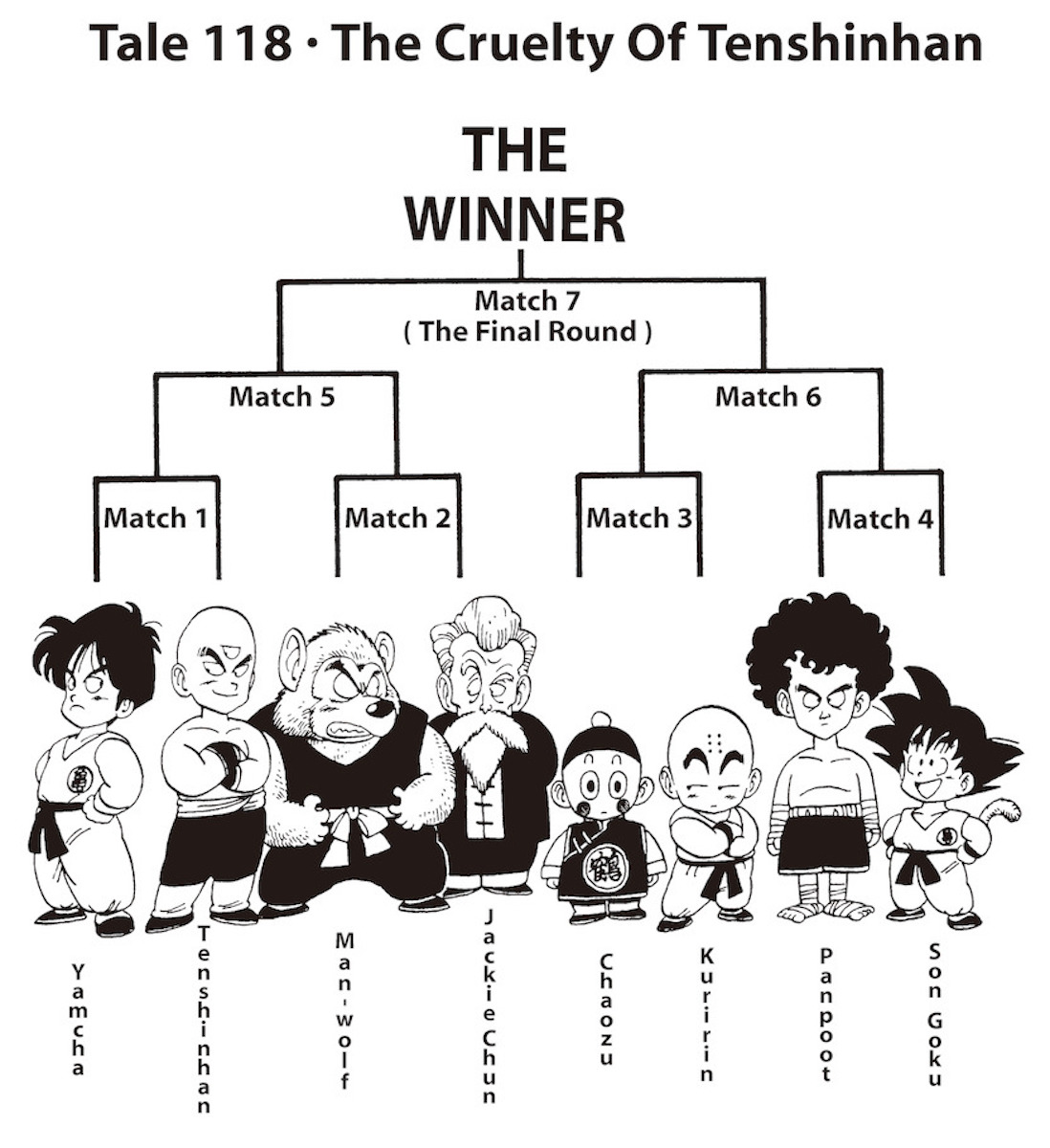
22nd Tenkaichi Budokai Bracket
Sakakibara: As a producer, I do want to try out something like this (laughs), but according to the athletic commissions who govern things like this in the United States, an athlete can only participate in a maximum of five rounds of five minutes each per day. This rule is in place to maintain the health of competitors. Japan doesn't have a commission like this, so restrictions can be determined by event organizers. But nowadays, the popular opinion is that even two bouts in one day is already taxing on athletes.
However, the rules were much more lax during the PRIDE years, so fighters like Kazushi Sakuraba and Royce Gracie fought six rounds of 15 minutes each, for a total of 90 minutes. Personally, I want the chance to see fights like that again! It'd be amazing to see competitions that go beyond our current regulations, ones without weight classes or time limits. Instead of following what the States do, I'd like to see a mixed martial arts tournament that better suits the spirit of Japan.
—Back in the 2000s, I remember that PRIDE and K-1 often held single-day tournaments.
Sakakibara: Back in the day with the PRIDE Grand Prix and K-1 Grand Prix, athletes fought in three rounds per day until they reached the finals. I'd say that's probably the limit.
—Anything more than that would be too taxing on the athletes, right?
Sakakibara: The exciting thing about tournaments and grand prix-type competitions is that "anything can happen". Even for someone who's got an unbroken losing streak under normal conditions, a fluke in the matchups or going against an opponent who's tired from a previous match might give them a shot at victory. Plus, if there's no time limit, putting a competitor who last fought an hour-long tough match against another who won theirs in just five minutes clearly puts the latter at an advantage. In a grand prix where multiple matches are fought per day, unexpected situations like that have a chance to happen. It's what gives them their own special appeal, unique from title matches where the fights start with competitors fully rested.
—We can't say for sure that it was due to his previous matches, but shockingly, Goku did ultimately lose in the 22nd Tenkaichi Budokai.
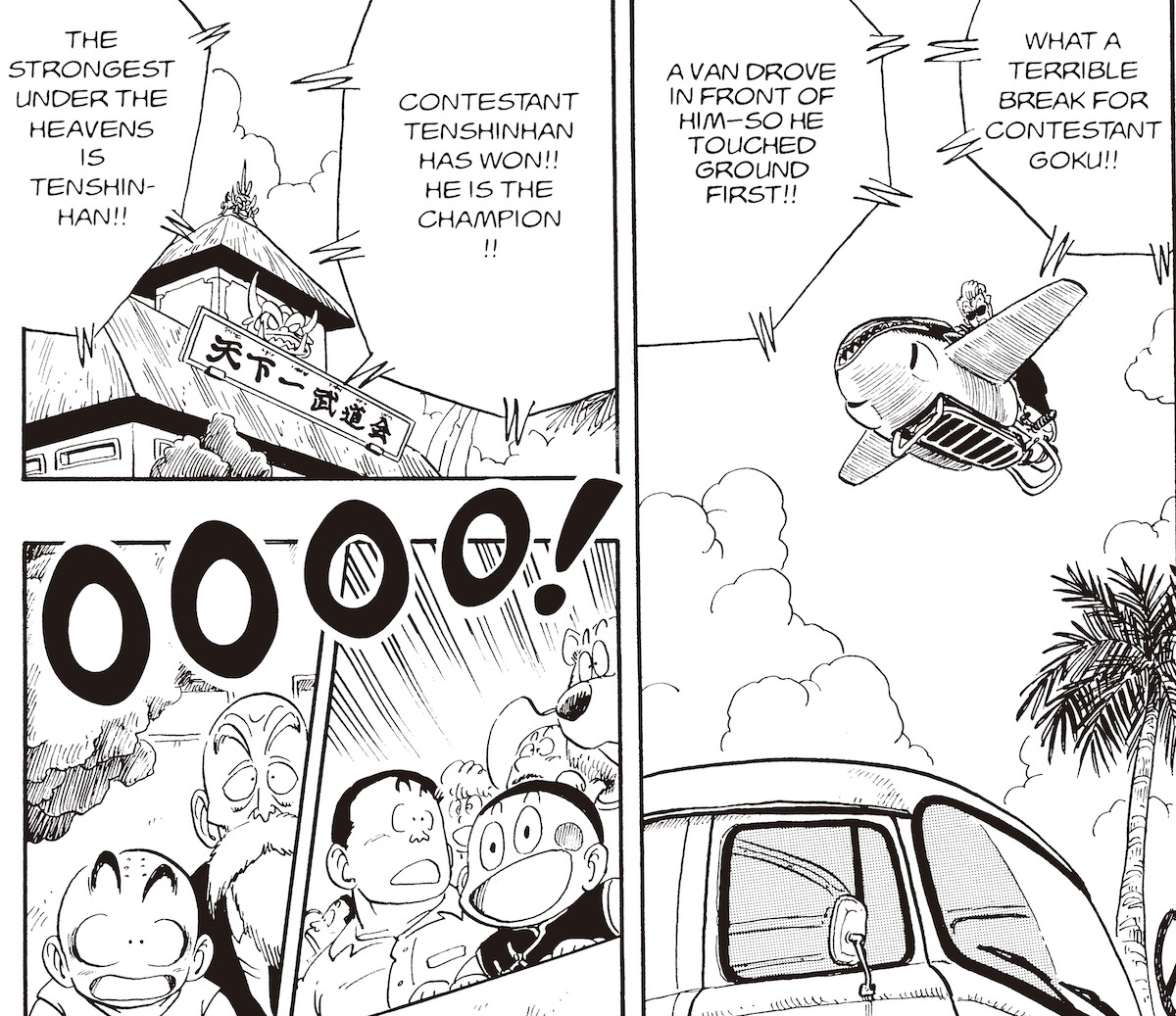
With victory in his sights, Goku is hit by a car and falls to the ground before Tenshinhan, resulting in his defeat
Sakakibara: Right, so I'd love it if we could hold a Tenkaichi Budokai in the real world (laughs). Obviously, for the participants, it would require a prize worth the risk. But I'm sure it would garner a lot of interest and be profitable on PPV (pay-per-view, in which viewers pay to watch content).
—I bet it'd be a hit.
Sakakibara: But from a business perspective, it would be a waste of potential to hold an event like this over only one day. For example, there could be regional preliminaries, and only the winners would be invited to the final tournament on Papaya Island.
—In that case, just making it to Papaya Island becomes a valuable prize.
Sakakibara: Right, Papaya Island and the martial arts temple would become something like a holy land to all martial artists. In the soccer World Cup, intense preliminaries are held all over for that chance to enter the main tournament, held only once every four years, right? The drama surrounding everyone fighting to make it to the main tournament is what builds up all the hype for it.
This is true for martial arts as well, but all entertainment events need to have a "peak". For RIZIN, that's New Year's Eve. The drama built up over every fight during the year culminates on that day. And then the next day, a new round of drama starts. That's how New Year's Eve matches serve as the "closing" event for the year. So, if I were to organize a Tenkaichi Budokai, I would have regional preliminaries that serve as a lead-up to the main tournament, which would be the peak of the whole event.
.jpg?_=1765714500)
—How about venue capacity? In the early parts of the story, there were surprisingly few spectator seats despite this being an event for deciding the strongest martial artist in the world. It feels like a waste of potential if you consider profits.
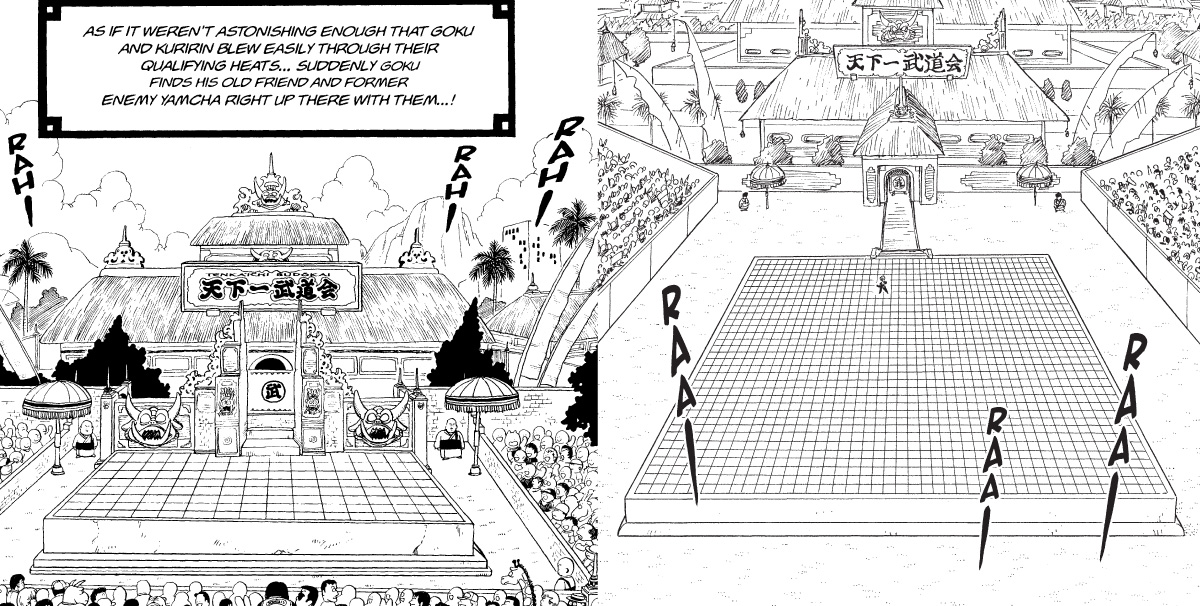
Left: The venue for the 21st tournament, Right: The venue for the 25th tournament. The ring and spectator seats were expanded significantly
Sakakibara: On the other hand, making it a closed event is another strategy to gather widespread attention. For example, let's say instead of holding an event in the Tokyo Dome or Japan National Stadium, which can seat tens of thousands of people, you hold it somewhere that can only seat a thousand. That would increase the number of people who would want to see it, which could increase your TV viewership and PPV sales.
—Makes sense. If the Tenkaichi Budokai was on PPV, then even people who couldn't make it to Papaya Island would be able to watch it.
Sakakibara: Actually, RIZIN also held an event in an extremely closed space during the COVID pandemic. It was in a certain venue in Tokyo, and only about 200 people got to watch the match between Mikuru Asakura and Kyohei Hagiwara in person. It was a necessity with how difficult it was to hold large-scale events during the height of the pandemic, but PPV sold very well as a result. I think making an event closed drives up the curiosity and excitement people have towards it. If you want to maximize profits, you have to think about how to present the event, and that's where us producers come in.
—Speaking of which, how much would you price a Tenkaichi Budokai ticket at?
Sakakibara: I'd say 1 million yen for a front row seat. Or 1 million Zeni, to be precise.
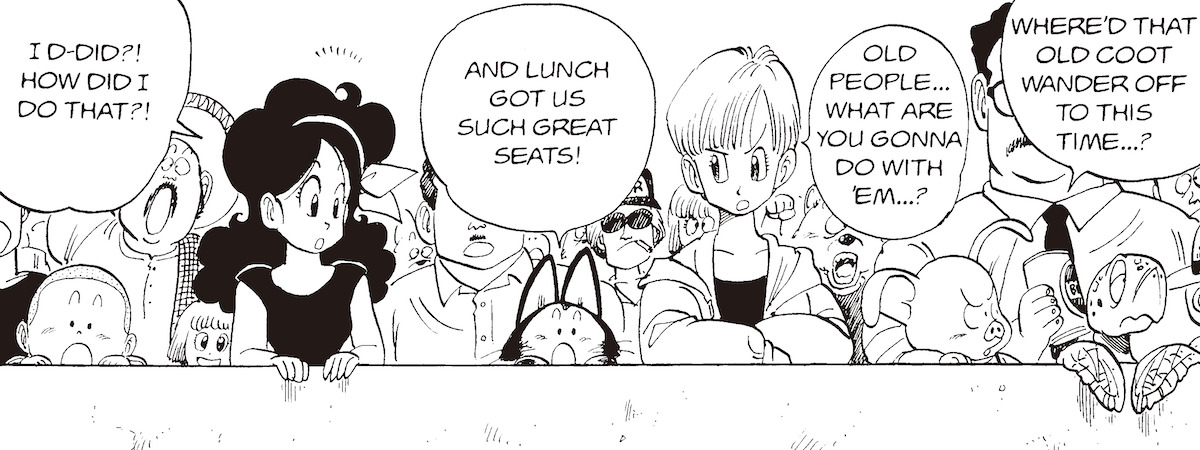
Even the characters know that the front row is the best place to be
That might still be on the cheap side. You get a close up of the eight strongest martial artists in the world fighting it out to the end, after all. That has an unbelievable amount of value.
—2025 marks the 10th anniversary of RIZIN. What would you need in order to make it a lasting event like the Tenkaichi Budokai, which has a history of over a hundred years?
Sakakibara: That depends on maintaining motivation in the competitors and passion in the fans. For the former, you need to make them think that this is a competition they're willing to stake their lives on. Call it "brainwashing" if you will. In the end, a producer can only control what happens up until the gong rings to start the match. What actually happens after that is out of our hands. So, what we have to do is make sure the competitors are willing to put their all into their matches.
To achieve that, we can make good matchups, stage the event to make things feel exciting, and of course provide an enticingly large sum as the prize money. But the biggest weapon in our arsenal by far is support from fans. If you hold the event in a venue that seats 40,000, but there are only 3,000 people attending, and there's barely anyone cheering on the competitors, then they aren't going to be giving it their all, no matter how good they actually are.
Now, if you hold the event in a venue packed to the brim with tens of thousands of people cheering, that's when the competitors' motivation is at its peak and that's when you see things turn out in ways you can't imagine. The drama and thrill you get from watching is also what gets fans coming back again and again. If you can create an environment where those two forces feed each other with their energy, that's when you get an event that can continue for a long time.
—Have you ever thought about adopting concepts from the Tenkaichi Budokai into RIZIN in order to keep that passion alive?
Sakakibara: Whether we add something new or not, I think a lot of us involved in the world of mixed martial arts have already been influenced by Dragon Ball and the Tenkaichi Budokai. Plenty of martial artists around the world have done the Kamehameha pose at some point or another. Tenshin Nasukawa and Hiromasa Ougikubo have even done so in the RIZIN ring. And just like we've already talked about, there's a lot of things we do that resemble the Tenkaichi Budokai from a management perspective. So, in that sense, it's not really an exaggeration to say that MMA has its roots in the Tenkaichi Budokai.
That's why our goal is to have martial artists and fans around the world view RIZIN as a "real-life Tenkaichi Budokai". No matter how small, passion from individuals adds up when brought together, so I hope to keep that passion alive. And hey, maybe someday we'll be able to get a kaiju in the ring after all (laughs).
.jpg?_=1765714500)
Interviewer/Writer: Noriyuki Enami (Yajirobe)
Photography: Kayo Sekiguchi
This site includes machine-translated texts. Please be aware that you might find some unusual expressions that are difficult to understand.
Post
Confirm Post
Post the above comment?
Reply
Confirm Reply
Post the above comment?
Are you sure you want to delete this comment?
Report successful
Post Unsuccessful
This user will be muted.
You will be unable to see comments from muted users in the comments area.
*To unmute users, navigate to the "Comments" area on MY PAGE.
Reply
Confirm Reply
Post the above comment?
Edit
Post
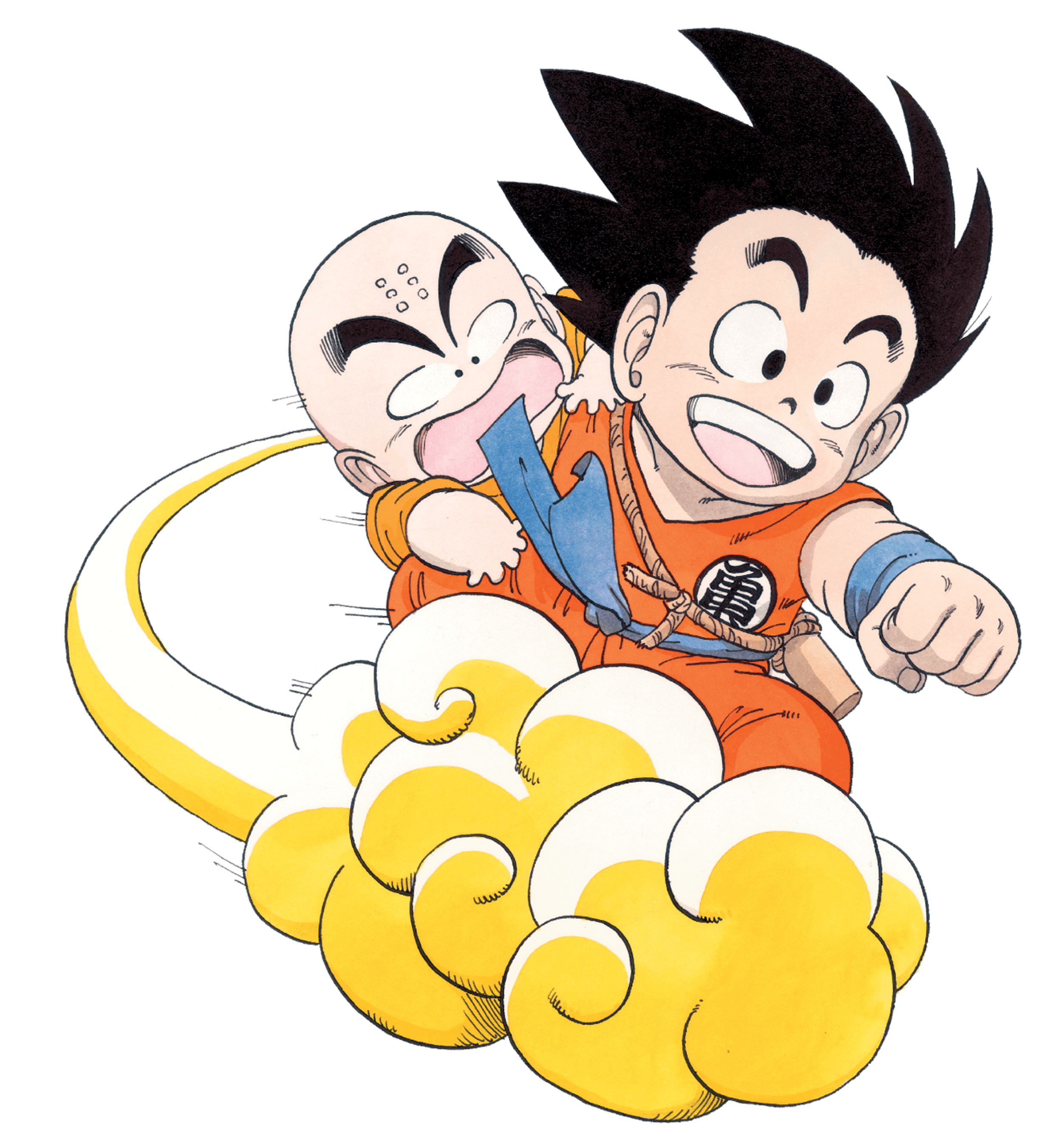

Post
Confirm Post
Post the above comment?
Edit
Post